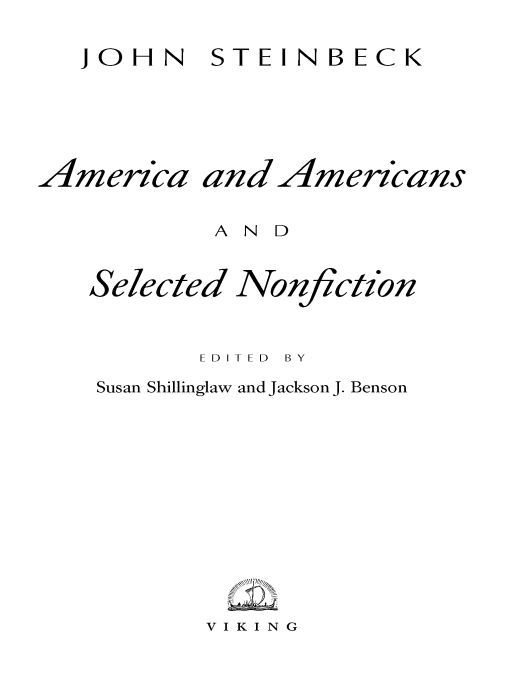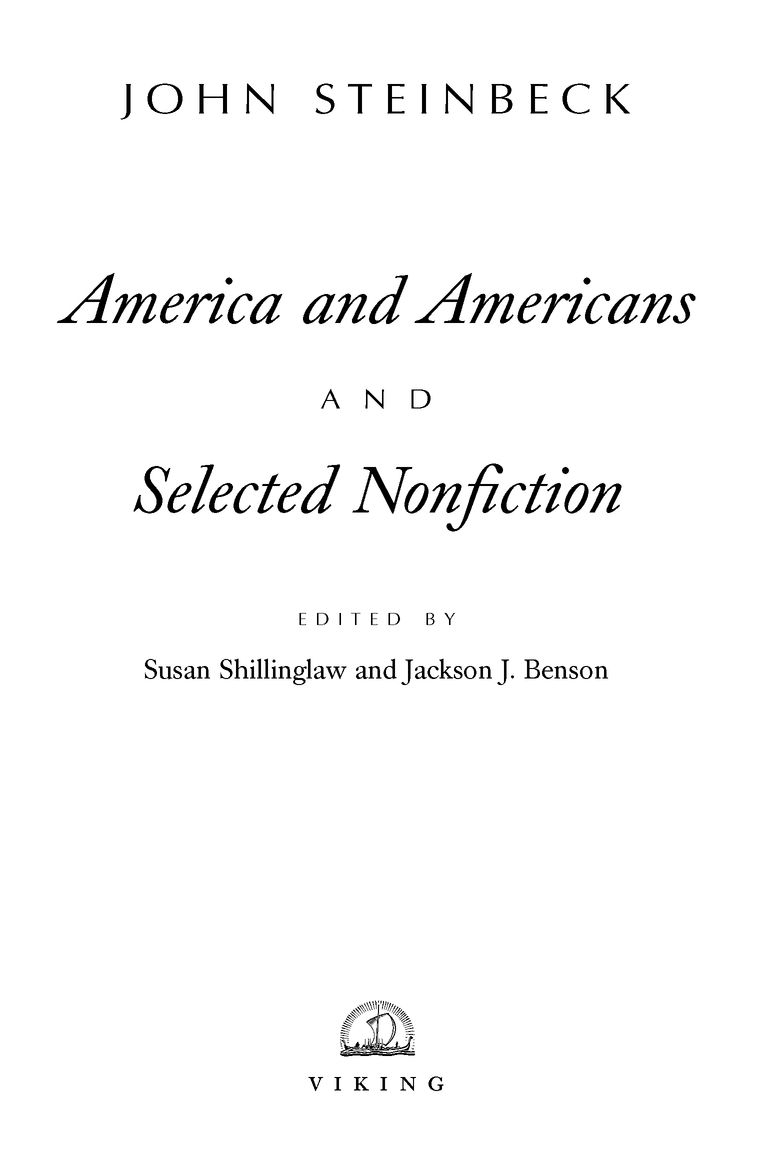America and Americans and Selected Nonfiction
Read America and Americans and Selected Nonfiction Online
Authors: John Steinbeck,Susan Shillinglaw
Tags: #Non-Fiction, #Classics, #Writing, #History, #Travel

BOOK: America and Americans and Selected Nonfiction
13.82Mb size Format: txt, pdf, ePub

Table of Contents
Â
Â
Â
Â
Â
Â
Â
Â
Â
Â

VIKING
Penguin Putnam Inc., 375 Hudson Street,
New York, New York 10014, U.S.A.
Penguin Books Ltd, 80 Strand, London WC2R 0RL, England
Penguin Books Australia Ltd, 250 Camberwell Road, Camberwell, Victoria 3124, Australia
Penguin Books Canada Ltd, 10 Alcorn Avenue, Toronto, Ontario, Canada M4V 3B2
Penguin Books India (P) Ltd, 11 Community Centre, Panchsheel Park,
New Delhi-110 017, India
Penguin Books (N.Z.) Ltd, Cnr Rosedale and Airborne Roads, Albany,
Auckland, New Zealand
Penguin Books (South Africa) (Pty) Ltd, 24 Sturdee Avenue,
Rosebank, Johannesburg 2196, South Africa
Â
Published by the Penguin GroupPenguin Putnam Inc., 375 Hudson Street,
New York, New York 10014, U.S.A.
Penguin Books Ltd, 80 Strand, London WC2R 0RL, England
Penguin Books Australia Ltd, 250 Camberwell Road, Camberwell, Victoria 3124, Australia
Penguin Books Canada Ltd, 10 Alcorn Avenue, Toronto, Ontario, Canada M4V 3B2
Penguin Books India (P) Ltd, 11 Community Centre, Panchsheel Park,
New Delhi-110 017, India
Penguin Books (N.Z.) Ltd, Cnr Rosedale and Airborne Roads, Albany,
Auckland, New Zealand
Penguin Books (South Africa) (Pty) Ltd, 24 Sturdee Avenue,
Rosebank, Johannesburg 2196, South Africa
Â
Penguin Books Ltd, Registered Offices:
Harmondsworth, Middlesex, England
Harmondsworth, Middlesex, England
Â
This edition first published in 2002 by Viking Penguin, a member of Penguin Putnam Inc.
Â
Â
Copyright © Elaine Steinbeck and Thomas Steinbeck, 2002All rights reserved
Â
America and Americans published by The Viking Press, 1966. Portions first appeared in The Saturday Evening Post. Copyright © John Steinbeck, 1966. Copyright renewed Elaine Steinbeck and Thom Steinbeck, 1994. Selection from “About Ed Ricketts” from The Log from the “Sea of Cortez.” Copyright John Steinbeck, 1951. Copyright renewed Elaine Steinbeck, Thom Steinbeck, and John Steinbeck IV, 1979. “Troopship,” “Waiting,” “Stories of the Blitz,” “Lilli Marlene,” and “Bob Hope” from Once There Was a War. Originally published in The New York Herald Tribune. Copyright © John Steinbeck, 1943, 1958. Copyright Elaine Steinbeck, Thom Steinbeck, and John Steinbeck IV, 1971, 1986. .
Â
Page 430 constitutes an extension of this copyright page.
LIBRARY OF CONGRESS CATALOGING-IN-PUBLICATION DATA
America and Americans, and selected nonfiction / John Steinbeck;
edited by Susan Shillinglaw and Jackson J. Benson.
p. cm.
Â
Steinbeck, John, 1902-1968.America and Americans, and selected nonfiction / John Steinbeck;
edited by Susan Shillinglaw and Jackson J. Benson.
p. cm.
eISBN : 978-0-142-43741-4
1. United StatesâCivilizationâ1945- 2. Steinbeck, John, 1902-1968âPolitical and
social views. 3. United StatesâSocial conditionsâ20th century. 4. Steinbeck, John,
1902-1968âJourneysâUnited States. 5. United StatesâDescription and travel.
I. Shillinglaw, Susan. II. Benson, Jackson J. III. Title
E169.1 .S8 2001
973.9'092âdc21 2001045434
social views. 3. United StatesâSocial conditionsâ20th century. 4. Steinbeck, John,
1902-1968âJourneysâUnited States. 5. United StatesâDescription and travel.
I. Shillinglaw, Susan. II. Benson, Jackson J. III. Title
E169.1 .S8 2001
973.9'092âdc21 2001045434
Â
This book is printed on acid-free paper.
Â
Without limiting the rights under copyright reserved above, no part of this publication may be reproduced, stored in or introduced into a retrieval system, or transmitted, in any form or by any means (electronic, mechanical, photocopying, recording or otherwise), without the prior written permission of both the copyright owner and the above publisher of this book.
INTRODUCTION
MOST AMERICANS know John Steinbeck's name, and many know his novels: The Grapes of Wrath, Of Mice and Men, Cannery Row, and East of Eden. His books, both fiction and nonfiction, still sell millions of copies every year, and one or another is part of the curriculum in schools throughout the United States. Few writers become beloved, their writing read with affectionate response long after their death. And few writers as popular as Steinbeck have written books that have for so long withstood critical and cultural crosscurrents. Like some other authors, such as Mark Twain, Robert Frost, and Willa Cather, John Steinbeck became beloved because he was so essentially American, a writer for and about the people.
But while his novels are familiar to many, his nonfiction is hardly known. From 1936 to 1966, Steinbeck wrote scores of short nonfiction pieces published in a variety of magazines and newspapers here and abroad. Most were read widely at the time and then gradually forgotten. By and large, however, these pieces are curiously modern and relevant. Steinbeck was a writer fully engaged in social currents, politics, and history. He takes on issues vital to the twentieth centuryâthe environment, poverty and homelessness, America's moral decline, major wars, racism, ethnicity. Other essays recount his life, his travels, his ideas, his projects. The range is impressive, the style unadorned and engaging, and the voice remarkably variedâreportorial, witty, impressionistic, impassioned.
This volume, published in celebration of Steinbeck's centennial, brings together for the first time representative articles, essays, and columns from his role as journalist and commentator. Also reprinted here for the first time since its original publication in 1966 is his last book, a series of commentaries on American life, America and Americans. Included also is the final, heretofore unpublished, chapter of Travels with Charley (1962). Some of these articles and essays are provocative, some moving, some thoughtful, and others amusing.
“What can I say about journalism?” he wrote in 1956. “It has the greatest virtue and the greatest evil. It is the first thing the dictator controls. It is the mother of literature and the perpetrator of crap. In many cases it is the only history we have and yet it is the tool of the worst men. But over a long period of time and perhaps because it is the product of so many men, it is perhaps the purest thing we have” (SLL 526).
1
In many ways, this selection of Steinbeck's nonfiction is the “purest” record of a writer immersed in his times. What reviewer Lewis Gannett said of Sea of Cortez may be extended to Steinbeck's corpus of literary journalismâthere is here “more of the whole man, John Steinbeck, than in any of his novels.”
1
In many ways, this selection of Steinbeck's nonfiction is the “purest” record of a writer immersed in his times. What reviewer Lewis Gannett said of Sea of Cortez may be extended to Steinbeck's corpus of literary journalismâthere is here “more of the whole man, John Steinbeck, than in any of his novels.”
Like Mark Twain before him, Steinbeck was a great democrat, skeptical of power and privilege, seeking to encourage the best that is in us and doing so sometimes in sorrow, sometimes in frustration or even anger, but sometimes, too, with tongue in cheek and a sly smile. In his roles as novelist or journalist, he always did his bestâhe cared deeply about his work, but like Twain, he seldom took himself too seriously. When he volunteered to cover the national political conventions in 1956, he wrote to the editors of the syndicated newspapers who would publish his columns: “Walter Lippmann, the Alsops and David Lawrence have nothing to fear from me. I have no sourcesâdependable or otherwise. If I should make a prediction, it will probably be assembled out of information from the wife of the alternate delegate from San Jose, California, plus whispers from the bell-hop who has just delivered a bucket of ice to âusually dependable sources' ” (SLL 526).
Steinbeck had a knack for choosing topics, as well as taking an approach, that would be of interest to ordinary people, usually putting himself in their place. But above all he had the ability through it all to entertain and inform. Indeed, these articles form a series of snapshots of a man who, through his compassion, concern, and sense of fun, has endeared himself to the American public, both in his life and since his death. It's in the spirit of that great range that the book is organizedâby topics that suggest the power of his thinking, the scope of his enthusiasms, and the varied approaches he took to the craft of literary nonfiction.
Â
John Steinbeck was lucky enough to live at a time when the concept of journalism as a profession was a fairly flexible notion. Newspapers sent novelists to cover stories, and Steinbeck, his reputation firmly grounded in the American psyche after The Grapes of Wrath, was fortunate to have his pick of material. Publications were usually happy to have his work, not only because of his name, but because he developed a reputation for applying his skills to even the most casual of pieces. From the time he published his first article in 1936 to his last in 1966, he took the writing of these little articles seriously, fretting over each one of them. “You know as well as I do that I have never turned out a really easy piece of copy in my life,” he wrote his agent Elizabeth Otis during a frustrating moment on assignment in 1952. “These articles are going to be just exactly as hard as anything I have ever done” (SLL 451).
Other books
The Painted Girls by Cathy Marie Buchanan
16 Lighthouse Road by Debbie Macomber
In the Shadow of the Crown by Jean Plaidy
McNally's Caper by Lawrence Sanders
Come Back by Sky Gilbert
Return to Me by Christy Reece
The Baby Surprise by Brenda Harlen
Inferno: Part 1 by Winters, Alyssa
Falling for Her by Sandra Owens
Fire In the Kitchen by Donna Allen